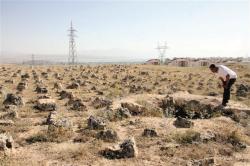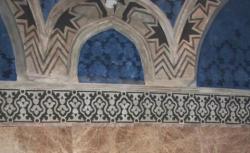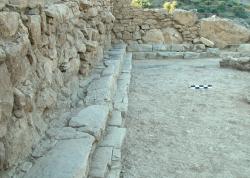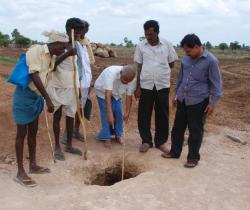INSTITUT SUPERIEUR D'ANTHROPOLOGIE
INSTITUTE OF ANTHROPOLOGY
ONLINE COURSES / COURS A DISTANCE
FALL TERM : OCTOBER 2014
REGISTER NOW
TURQUIE –  Van - An area of 1,600-squaremeters, where more than 2,000 stelas have been erected by the Urartian Kingdom through mathematical calculations, and underground rock graves need attention to contribute to Turkish tourism. The structures, which date back to 3,000 years ago when the Urartians lived in the region in the eastern province of Van’s Tuşba district, shed light on the lifestyle of the past, as well as scientific work in the ancient era. The stelas and stone circles, located in the necropolis (graveyard) area 1.5 kilometers northeast of the Kalecik neighborhood, reveal that the Urartian people dealt with the science of astronomy. The area is home to round stones and differ in 13-40 meter diameters, and 25 underground graves, as well as 2,475 stelas. Yüzüncü Yıl University Head of Archaeology Department Associate Professor Rafet Çavuşoğlu said the 20-500 kilograms of stones, which were brought from the stone pits on the Şahbağı Hill, were placed in the area with great attention. The stones, which are placed on a straight surface, were also used in astronomy in the Urartian era. “We consider the possibility that a great state like the Urartians had a calendar system. Foreign academics approve this view, too. There are such places made up of monolith stones in Europe and the Near East, too. They are around Syria, Khazar and the Aral Sea. Urartians have the gods of the sun and moon. Since they used the moon calendar, we think this place had a religious function. We held observations here on Dec. 21 and June 21, the shortest and the longest days of the year, respectively. We saw that the sun went down from the skirts of the Süphan Mount Sığırlar Hill on June 21, and went down on Dec. 21 with long shadows on the stones through the Kalecik Fortress and Lake Van. This place was used as an observation house in the Urartian-era,” he explained. Çavuşoğlu noted the array of the stelas, their location and intended purpose have great similarities with Stonehenge, which is visited by thousands of people every year. “This structure in Britain has an archaeological function and 1 million people visit this place every year. Therefore we named this place the ‘Stonehenge of Anatolia.’ We published our information about the area in Turkey and abroad. The stones here look like the ones in Stonehenge, where religious ceremonies related to astronomy were held. There is no other place like this in Anatolia. He said the same area was also home to 25 underground graves, but those graves were looted by treasure hunters. “These graves were also constructed according to a certain plan,” he said.
Van - An area of 1,600-squaremeters, where more than 2,000 stelas have been erected by the Urartian Kingdom through mathematical calculations, and underground rock graves need attention to contribute to Turkish tourism. The structures, which date back to 3,000 years ago when the Urartians lived in the region in the eastern province of Van’s Tuşba district, shed light on the lifestyle of the past, as well as scientific work in the ancient era. The stelas and stone circles, located in the necropolis (graveyard) area 1.5 kilometers northeast of the Kalecik neighborhood, reveal that the Urartian people dealt with the science of astronomy. The area is home to round stones and differ in 13-40 meter diameters, and 25 underground graves, as well as 2,475 stelas. Yüzüncü Yıl University Head of Archaeology Department Associate Professor Rafet Çavuşoğlu said the 20-500 kilograms of stones, which were brought from the stone pits on the Şahbağı Hill, were placed in the area with great attention. The stones, which are placed on a straight surface, were also used in astronomy in the Urartian era. “We consider the possibility that a great state like the Urartians had a calendar system. Foreign academics approve this view, too. There are such places made up of monolith stones in Europe and the Near East, too. They are around Syria, Khazar and the Aral Sea. Urartians have the gods of the sun and moon. Since they used the moon calendar, we think this place had a religious function. We held observations here on Dec. 21 and June 21, the shortest and the longest days of the year, respectively. We saw that the sun went down from the skirts of the Süphan Mount Sığırlar Hill on June 21, and went down on Dec. 21 with long shadows on the stones through the Kalecik Fortress and Lake Van. This place was used as an observation house in the Urartian-era,” he explained. Çavuşoğlu noted the array of the stelas, their location and intended purpose have great similarities with Stonehenge, which is visited by thousands of people every year. “This structure in Britain has an archaeological function and 1 million people visit this place every year. Therefore we named this place the ‘Stonehenge of Anatolia.’ We published our information about the area in Turkey and abroad. The stones here look like the ones in Stonehenge, where religious ceremonies related to astronomy were held. There is no other place like this in Anatolia. He said the same area was also home to 25 underground graves, but those graves were looted by treasure hunters. “These graves were also constructed according to a certain plan,” he said.
http://www.hurriyetdailynews.com/stonehenge-of-anatolia.aspx?pageID=238&nID=70051&NewsCatID=375
ROYAUME UNI – Abbey Barns - The Roman bath-house, at Abbey Barns, was discovered in 2011 close to a Roman villa excavated in 1960. Work in 2013 showed that much of the building survived in wonderful detail. There were stone walls, polished terracotta floors and even under-floor hypocaust heating, all untouched. They were covered by tons of ceramic roof tiles and the collapsed stone walls covered huge amounts of box flue tiles which were used to direct hot air up the interior walls. The team also discovered numerous Roman household items, including silver jewellery, bone hair pins and the remains of glassware. There is still ongoing investigation into the use of some parts of the building. They have discovered that it was originally built in 2AD as a barn. The dig with the Kent Archaeological Field School runs until August 17.
http://www.canterburytimes.co.uk/Archaeologists-start-new-dig-Roman-bath-house/story-22085129-detail/story.html
BULGARIE –  Burgas - The restoration of the Suleiman the Magnificent bath in Burgas is almost complete and will open for visitors next year, report the Bulgarian-language media. The XVI century building is in the Aquae Calidae archaeological complex in Burgas, near the mineral water springs. The bath has been restored to its original Oriental appearance. According to the 24 Chasa daily, there is an idea to turn the Suleiman bath in to a working bath, but for that is necessary the permission of the National Institute for Cultural Inheritance. The excavations in the area started in 2009 and have uncovered Roman baths, also restored, a Roman temple of the three nymphs, patrons of the healing waters and various artifacts from the Byzantine and Ottoman empires. Besides the Suleiman and the Roman baths, the complex will also include a museum, displaying the various artifacts. -
Burgas - The restoration of the Suleiman the Magnificent bath in Burgas is almost complete and will open for visitors next year, report the Bulgarian-language media. The XVI century building is in the Aquae Calidae archaeological complex in Burgas, near the mineral water springs. The bath has been restored to its original Oriental appearance. According to the 24 Chasa daily, there is an idea to turn the Suleiman bath in to a working bath, but for that is necessary the permission of the National Institute for Cultural Inheritance. The excavations in the area started in 2009 and have uncovered Roman baths, also restored, a Roman temple of the three nymphs, patrons of the healing waters and various artifacts from the Byzantine and Ottoman empires. Besides the Suleiman and the Roman baths, the complex will also include a museum, displaying the various artifacts. -
http://www.novinite.com/articles/162579/Suleiman+the+Magnificent+Bath+In+Burgas+To+Open+for+Visitors
BULGARIE –  Sofia - Ancient walls dating back to the 2nd-4th century were found during the reconstruction of Sofia's landmark Lavov Most (Lion's Bridge) on Thursday. Excavations were scheduled in the area to coincide with the repair works after one of them was found while the second line of the Sofia Metro was being built a few years ago. Combined with the two fresh discoveries, however, it gives experts ground to believe they have come across Roman walls that were part of an engineering facility that was connected to placing a bridge over the Perlovska river, Aleksandar Stanev, who leads the excavations, told Darik Radio. Four more pieces could be registered soon, as there are indications other remains of walls are lying under the ground just off the river banks and "some of them even in river itself," Stanev added.
Sofia - Ancient walls dating back to the 2nd-4th century were found during the reconstruction of Sofia's landmark Lavov Most (Lion's Bridge) on Thursday. Excavations were scheduled in the area to coincide with the repair works after one of them was found while the second line of the Sofia Metro was being built a few years ago. Combined with the two fresh discoveries, however, it gives experts ground to believe they have come across Roman walls that were part of an engineering facility that was connected to placing a bridge over the Perlovska river, Aleksandar Stanev, who leads the excavations, told Darik Radio. Four more pieces could be registered soon, as there are indications other remains of walls are lying under the ground just off the river banks and "some of them even in river itself," Stanev added.
http://www.novinite.com/articles/162594/Three+Ancient+Walls+Discovered+During+Bridge+Repairs+in+Sofia
GRECE –  Azoria - Archaeologists from USA and Greece are working in the area of Kavousi, on the island of Crete, to uncover an ancient Greek city that had been lost for millennia. Archaeologists and students from North Carolina and across the US, as well as local Cretan workers, are studying the findings of Azoria, a city destroyed by fire about 2,500 years ago. So far, no graveyards have been found, and depictions of language on pottery at the site are indecipherable. The team is working on gathering historical clues from the remnants of buildings, personal items, implements and food. The project is spearheaded by Donald Haggis, an archaeology professor at the University of North Carolina-Chapel Hill. Haggis and his team have been working on the project since 2002. Greek officials monitor the excavation as all antiquities found must remain in Greece. Until now, excavations revealed a building that was likely a place of communal meals called “syssitia.” The building includes dining rooms, kitchens, and storerooms that had remnants of grapes, olives and grains. Among the findings there is a Monumental Civic Building, a large hall with a stepped bench built into the walls and an adjoining two-room shrine including small divinity dolls. It also has an olive press facility. The site of Azoria was first discovered in 1900 by American archaeologist Harriet Boyd Hawes. However, she had only conducted a trench test, because she was looking for older Minoan ruins.
Azoria - Archaeologists from USA and Greece are working in the area of Kavousi, on the island of Crete, to uncover an ancient Greek city that had been lost for millennia. Archaeologists and students from North Carolina and across the US, as well as local Cretan workers, are studying the findings of Azoria, a city destroyed by fire about 2,500 years ago. So far, no graveyards have been found, and depictions of language on pottery at the site are indecipherable. The team is working on gathering historical clues from the remnants of buildings, personal items, implements and food. The project is spearheaded by Donald Haggis, an archaeology professor at the University of North Carolina-Chapel Hill. Haggis and his team have been working on the project since 2002. Greek officials monitor the excavation as all antiquities found must remain in Greece. Until now, excavations revealed a building that was likely a place of communal meals called “syssitia.” The building includes dining rooms, kitchens, and storerooms that had remnants of grapes, olives and grains. Among the findings there is a Monumental Civic Building, a large hall with a stepped bench built into the walls and an adjoining two-room shrine including small divinity dolls. It also has an olive press facility. The site of Azoria was first discovered in 1900 by American archaeologist Harriet Boyd Hawes. However, she had only conducted a trench test, because she was looking for older Minoan ruins.
http://greece.greekreporter.com/2014/08/07/ancient-greek-city-discovered-in-crete/?
INDE –  Nossam - Kurnool district emerges as an important human habitat during the prehistoric time with archaeologists discovering places one after the other. The latest prehistoric dwelling was discovered at Nossam in Koilkuntla mandal of the district. K. Ramakrishna Reddy, Assistant Archaeologist of ASI, Hyderabad, who undertook a detailed study of the place, found Akkampalli caves and rock painting a few years ago. Of late, the team discovered another batch of caves near Nossam which was of great significance historically. The group of archaeologists noticed several pictures drawn on cave walls which include honey comb, snake, a variety of flora and fauna. Deer and other animals were prominent. Mr. Ramakrishna Reddy said honey appears to be an important food item of the prehistoric man apart from meat of wild animals. The team collected various stone implements like hand-axe made of quartzite, which was an important tool of middle Palaeolithic period. Also, blades, lunates, trapezes, triangles and non-geometrical implements made of flint, chalcedony and jasper were collected from the site, which were in plenty. Many harvesting tools were recovered. The site was roughly estimated to be of 30,000 to 40,000 years old. According to Mr Reddy, the site was more important because of the continuity of culture and dwelling. Honey collection was a popular avocation among certain semi-nomadic tribes in the area even today. Ketavaram was also important prehistoric site in Kurnool district, which was contemporary of Nossam site.
Nossam - Kurnool district emerges as an important human habitat during the prehistoric time with archaeologists discovering places one after the other. The latest prehistoric dwelling was discovered at Nossam in Koilkuntla mandal of the district. K. Ramakrishna Reddy, Assistant Archaeologist of ASI, Hyderabad, who undertook a detailed study of the place, found Akkampalli caves and rock painting a few years ago. Of late, the team discovered another batch of caves near Nossam which was of great significance historically. The group of archaeologists noticed several pictures drawn on cave walls which include honey comb, snake, a variety of flora and fauna. Deer and other animals were prominent. Mr. Ramakrishna Reddy said honey appears to be an important food item of the prehistoric man apart from meat of wild animals. The team collected various stone implements like hand-axe made of quartzite, which was an important tool of middle Palaeolithic period. Also, blades, lunates, trapezes, triangles and non-geometrical implements made of flint, chalcedony and jasper were collected from the site, which were in plenty. Many harvesting tools were recovered. The site was roughly estimated to be of 30,000 to 40,000 years old. According to Mr Reddy, the site was more important because of the continuity of culture and dwelling. Honey collection was a popular avocation among certain semi-nomadic tribes in the area even today. Ketavaram was also important prehistoric site in Kurnool district, which was contemporary of Nossam site.
http://www.thehindu.com/news/national/andhra-pradesh/prehistoric-site-found-at-nossam/article6288418.ece?utm_source=RSS_Feed&utm_medium=RSS&utm_campaign=RSS_Syndication
INDE –  Dasarm- A rare Megalithic cist burial (Gudu samadhi) belonging between 1000 BCE and 600 CE has been found in a farm at Dasaram village, located close to Musi river in Nereducherla mandal in Nalgonda district. Annapureddy Chandra Reddy, a farmer, stumbled upon the burial when the tractor ploughing agricultural land got stuck in slush. Archaeology and Museums Department officials led by Assistant Director D. Ramulu Nayak and former conservator Y. Bhanu Murthy inspected the site and concluded that it was cist burial belonging to Megalithic period. Speaking to The Hindu, Mr. Murthy said apart from the burial ground, they found stones used for sharpening weapons and slingshots used for protecting crops from birds. “People of that time used to bury the things used by the deceased person during interment ,” he said. The burial has stones on four sides and capstone on the top . Similar burials were found at archaeological sites located at Phanigiri and another near Bhongir in district in the past, but they were yet to be excavated.Shockingly, Mr. Murthy said, the local farmers have damaged at least 15 to 20 such burials unknowingly while ploughing their farms. The archaeological site is still having at least 30 more such burials which would give more insights once excavated.
Dasarm- A rare Megalithic cist burial (Gudu samadhi) belonging between 1000 BCE and 600 CE has been found in a farm at Dasaram village, located close to Musi river in Nereducherla mandal in Nalgonda district. Annapureddy Chandra Reddy, a farmer, stumbled upon the burial when the tractor ploughing agricultural land got stuck in slush. Archaeology and Museums Department officials led by Assistant Director D. Ramulu Nayak and former conservator Y. Bhanu Murthy inspected the site and concluded that it was cist burial belonging to Megalithic period. Speaking to The Hindu, Mr. Murthy said apart from the burial ground, they found stones used for sharpening weapons and slingshots used for protecting crops from birds. “People of that time used to bury the things used by the deceased person during interment ,” he said. The burial has stones on four sides and capstone on the top . Similar burials were found at archaeological sites located at Phanigiri and another near Bhongir in district in the past, but they were yet to be excavated.Shockingly, Mr. Murthy said, the local farmers have damaged at least 15 to 20 such burials unknowingly while ploughing their farms. The archaeological site is still having at least 30 more such burials which would give more insights once excavated.
http://www.thehindu.com/news/national/telangana/megalithic-cist-burial-unearthed-in-nalgonda/article6292284.ece